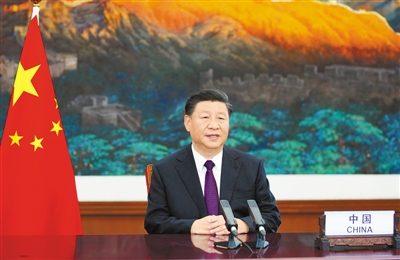By Xuefei Chen Axelsson
Greenpost&ChinaEuropeDialogue reporter: Hello, Everyone, I am Xuefei Chen Axelsson, chief editor of Green Post and China Europe Dialogue in Stockholm. We focus more on sustainable development and climate issues. Today we shall focus on China. And I feel honoured to invite Mr. Erik Solheim, former UNEP Executive Director and Norwegian Member of Parliament and former minister of environment and foreign aid for development. He is an expert in environmental protection, climate change and new energy and related issues. Welcome Mr. Solheim!
Solheim: thank you it is great to be on your show.

Greenpost: As we know Chinese President Xi Jinping has promised at the United Nations that China will achieve carbon neutral by 2060. What does it mean for the world or for our earth? Are you confident that China really can achieve this goal?

Solheim: Yes, I am confident that China can achieve this because China has achieved enormous advance in the past. Because in the last 40 years China has eradicate extreme poverty. For the first time when I went to China, there was no private cars, everyone was very poor.
And they were basically only eating rice and noodles. Now China has lifted in a way nowhere else in the world can. If a nation can bring 1.4 billion people out of poverty, of course it can also create an ecological civilization and help the world move in the green direction.
Q: China said it will reach its peak in green house emission by 2030. Do you think China can realize this promise? What are the challenges China has to face?
Solheim: First of all, China is now the leader in basically every environmentally friendly technology, some of the green technologies may have been developed in California or Germany. But when it comes to the scale and make it affordable for the world, China is no double the leader. Half of the solar energy panels have been developed in China. So far China is also in the lead in hydrogen, wind power and electric mobility. About 90 percent of the electric bus in the world are running on Chinese roads. So yes, indeed, we see the speed of transformation in green issues is also very very unprecedented, so I am confident that China will reach its peak in green house emission by 2030, maybe hopefully even earlier.
Q: Right now in many ways, China and the US are in competitive situation. In what way do you think the US will put pressure on China in terms of industrial development and deployment?
Solheim: Competition in itself is not bad. I mean if companies in China and the United States can compete and develop in green technology, it is only good. At the moment, China is well ahead in many green technologies. I mean China is making 70 times more solar panels than the United States. So America only needs to move quickly ahead to catch up. But that business competition must be complemented by government cooperation. You should avoid any idea of cold war or talking about technology decoupling. These are very dangerous ideas. If the two major power in the world, the United States and China, if they work together, they cooperate on the crisis limit, we can create miracles in the world. If they allow tensions to build up, not to speak of violence and wars, it will be very dangerous. So let’s work on how to solve the big issues for humanity together, climate change, environmental destruction and pollution.
Greenpost: China has made great efforts in dealing with climate change. But likely still face a lot of pressure from the west, as an expert in this field, can you elaberate a bit what kind of pressure that can be?
Solheim: First of all, it is completely unfair to blame China, not to speak of India for climate issue, US emissions up to today is 8 times more than that of China in per capita and 25 times more than India in per capita. Emissions even in small nations like Sweden and Norway, still higher than China in per capita. So the west should stop blaming the big developing nations like China and India for the climate crisis. It is the west side that made this crisis happening. However, China also needs to address this question, not for us, but for China. India also needs to address this problem, not for the west, but for India, because Asia is more vulnerable to climate crisis than Europe or North America are. So we see both China and India are moving very fast to green technologies in practice and in many areas also in ideas. What China should consider or should understand is that many European companies think sometimes the competition is unfair, that green technologies are more subsidied in China than in Europe, which in my view it is good, you need to subsidize them. But we need to make sure that there is equal market access. And that is behind the idea of having green tariff, European companies want to see a fair competition. There should be a dialogue between China and Europe as to how to establish the most fair basis for competition while at the same time cooperate to achieve the common goals for humanity to defeat climate change.
Greenpost: Western companies complaint may be come from the change of tax policies in China. At the beginning in the 1990s, China gave a lot of perferential policies to foreign companies, that is to say their tax is 15% while the Chinese companies 35%. But later China changed to equal policies for both Chinese and foreign companies. That mean both have 25% tax.
Solheim: I think it is completely crazy for the west to blame China for unnecessary subsidies for green industries because it is a big problem in the world that we still gave a lot of subsidies to oil, gas and even to coal. We should stop giving all the subsidies to oil industries and move forward. However if the western companies feel the competition is unfair because China still subsidize companies that gave a lot of emissions, for example in coal sector, then we should look into these issues and find a settlement for them. That is what behind this idea of green tariffs. But I think it will be very hard to set up a system for green tariff. So the best way for it is a deep dialogue on how to avoid it.
Q: What is your comment about China’s green technology development such as solar, wind power and new energy?

Solheim: It is absolutely astonishing. As I said, some of the initial patents may come from Europe och North America, but China is the nation that has brought these into large scale and brought down the price so that solar, wind energy are available to everyone.
We had a disastrous Climate conference in Copenhagen in 2009, no one, not one person said, oh, by the next ten years, the price of green energy would decrease by 90 percent. That thanks to China and India because they brought the scale of renewables to a completely new level. But that also transformed the entire global discussion because people no longer mention a choice between the development and environment, you have now all the win-win policies—good for environment and good for mother earth and good for providing jobs exactly at the same time. And that is the policy we should deploy because there are still millions of millions of people in the world need to develop very fast. We should do that while we should also take care of out planet.
Q: In some sense, don’t you think that China has somewhat systematic advantage in realizing these goals? Some people think whatever the Communist Party of China say their people will listen, but it is not that easy as you imagined.
Solheim: China obviously has a very effective governing system, it is responding also to demand from my clear view is that many people in China became so tired of the enormous pollution. If you talk with the middle class in the big cities, they would say, we don’t want this any longer, we want to see the sun! And then the message went to the leadership, the state and the party and that is why we see now the environment issues are so high on the agenda in China. But to me the most striking thing is in west and in China we are facing exactly the same problems. We both want to reduce the disparity in society. Like in Europe and America, we take capitalism and want people to have entrepreneurship and increase the welfare. But West and China face exactly the same。And we should learn from each other in how to handle them.
Q: How can the Chinese people benefit from achieving these goals and how the world benefit from China’s action?
What many people have not understood is that China is not only leading in green technologies, but China now also more and more is the leader in environmental practice in how to change the world in the green direction. The good example is the green areas in the desert in inner Mongolia. The cleaning of the river water in Zhejiang province is also very astonishing. Some of the rivers were like the milky way or called milk river, not because they are healthy, but because they are completely white, like milk. Not healthy. But after cleaning , every child can go bathing in the river again. Also some of the Chinese cities are now leading their way towards a green future. Hangzhou and Suzhou are very green cities. Shenzhen also has great green corridor in the city. All the buses and taxis are electric in Shenzhen. They have wetland for birds in the city center. So the west actually now have a lot to learn from China in environmental practice. For sure, we can learn from each other and China can look at elsewhere in green technologies and learn from best practices in Europe, America or India.
Q: Do you think there will be a spill over impact of China’s realization of its climate goal by 2060 so that many countries can also get China’s technology and products in dealing with climate change? Please give some examples?
Solheim: Yes I think one of the good example is that Chinese President Xi jinping has said that China will stop funding all the overseas coal investments, that is the most important environmental decision in the world this year. It will not only phase out the coal, but it acts like a time machinary for China to build solar, wind energy and electric mobility. So you see a surge in that direction. Belt and Road countries in Asia, Pakistan, Vietnam, African countries in South Africa and Kenya, if they can’t get coal investment in China what will they do? Immediately they will demand solar and wind investment to deliver, so this is a game changing decision by China. May I also mention that the green infrastructure finished by China. Last month the railway built by China in Laos opened for operation, for the first time linking Laos to China. That can link to Europe because if you have goods from Laos and then transport to China by train and then through China Europe express, you can send the goods to Germany. It will be a completely new world for Laos. China has built metro in Vietnam and it opens for traffic too. So even though sometimes there was political tension between Vietnam and China, China still was able to build the metro in Hannoi. So these are China’s great contributions to the world.
Q: China is still a developing country but it is a big developing country with a huge production capacity and potential market. Norway is a small country, but Norway has advanced technologies and highly developed in many ways, how can China and Norway cooperate in mutually beneficial way?
Solheim: Since China is so big and Norway is so smal, I think it is useful to focus on where Norway has specific world leading technology. Norway absolutely is at forefront when it comes to offshore wind and we have a long history of dealing wind at sea. So wind energy at sea has a great potential for the future.
Norway has a 100 years of history in green energy and hydrogen, now we provide green hydrogen to ferris, ships and other variation. We are extremely successful in popularize electric cars. 80 percent of our cars sold are electric. We are also leading in the world in green energy for our ferries due to our green policy from the government. So using green hydrogen in ferries and ships are world leading technologies. There can be many other areas, but I think we can focus on these three areas offshore wind energy, hydrogen for ferries and ships, trucks and aviation, electric cars for partnership with China.
Q: As we have discussed, Chinese President Xi Jinping has put up forward an initiative called belt and road initiative hoping to enlarge cooperation with countries along the road and at sea, in what way do you think Norway and China can cooperate in this aspect? Trading?, telecommunication? Satelite for arctic region? What is your vision about such cooperation? Even timber industry? Through China Europe fast train? Or green technology from Norway?
Solheim: Of Course, Belt and road is the biggest initiative in the current world because it involves 130 more nations who participate. Nearly all the African countries are involved in Belt and Road initiative. For Norway we can cooperate in offshore wind, green hydrogen for ferries, ships and trucks and aviation, electric cars and maybe green farming. Norway’s green farming is also leading the world, very good. Norway also like to have the green magnet navigation and good at that area for example navigating to China, out of 10 biggest port in the world, 7 of them are in China. China and Norway can cooperate in green shipping industry too.
Q: Norway is advanced in many ways and historically China and Norway have been very friendly. For example, Norway build up hospitals for the Chinese before and after China’s liberation. In the new era, how can China and Norway continue to develop their friendly and mutually benefial relations?
Solheim: I think you should also look at people to people relations. It is not about business or politics, it is just people coming together. During the covid period it has been very difficult. But after the covid, we hope to see many more tourists for both directions visiting each other’s country. Talking about this, I like to mention that very negative treatment of China in western media is completely unfair for China. Western media only looks for negative news from China and report on them. Some of the negative news are true, some of them are fake news. But it created a distorted image of China. We don’t see many negative news about Norway, but we see many very negative news about America in some of the Chinese social media. China should also reign these very negative news about America. Because we need to respect each other, there are many problems in America, but we should also realize this is the most fabulous nation on earth in many ways.
Q: Lastly Norway will participate in Beijing’s winter Olympics, will you say something to the athletes and to Beijing the host?
Solheim: Norway has been the top at Pingchang Olympics. I hope our athletes will see more about Beijing, and Hebei province, especially the train between Beijing and some of the sites in Zhangjiakou is very environmentally friendly, and it can be the most green winter Olympics. I feel it is unfortunate that American diplomatic bojkatt arouse a lot of attention. People should sit down and talk about cultural differences.
Reporter: Thank you for being with us.


